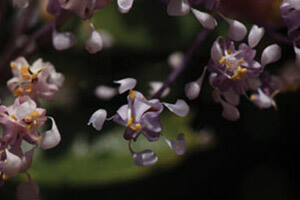
Scientific name: Ceanothus prostratus (Rhamnaceae)
Synonyms: Ceanothus divergens
Origin: Western North America (see map)
Plant description: Ceanothus prostratus is a dense mat or mound-like bush or shrub that is generally less than 3m (~ 118 in). The Stems are spreading and root at their nodes.1 The twigs are reddish brown. The evergreen leaves are placed oppositely, some of them clustered. The petiole (leaf stem) is 1 to 3 mm (~0.04-0.12in) and there are stipules2 that are knob-like. The leaves are oblanceolate3 to obovate and are 9 to 30 mm (~0.35-1.18 in) long and 4-16 mm (~0.16-0.63 in) wide. The upper surfaces are more or less hairless and dark green and the lower surfaces pale. There are generally 3-9 marginal sharp pointed teeth around the leaf with the overall leaf end more or less rounded.
The inflorescence is umbel-like.4 The flowers are colored blue, lavender or purple.
The fruits are 6-9 mm (0.24-0.35 in) wide, wrinkled with 3 ridges at the unattached end that extend into three 1-2 mm (~ 0.04-0.08 in) slender to thick horns.[12]
Distribution: See map
Blooming period: April-June[6], May and June[8], May[5]
Importance as a honey plant: To this writer the genus Ceanothus seems quite complex. By my count, the USDA website currently lists 50 species. There are also a long list of scientific names that were once applied to the currently accepted species that are now considered synonyms. In addition, there are also a number of what are considered hybrids.
Oertel[7] from his questionnaires found the species described above to be of at least some importance in California. Ayers and Harman[1], from their questionnaires, while not able to identifiy the species, found the genus to be of at least some importance in AZ, CA, ID, NV, OR, and UT. Burgett Stringer and Johnson[2] write a small amount about three species of Ceanothus found in Oregon and the Pacific Northwest, but they provide nothing about C. prostratus. Vansell and Eckert[11] mention a species which they call wild lilac (p65), but they seem to have nothing to say about C. prostratus. John Lovell mentions the species and very briefly describes the honey (see Honey below). Ramsay[9] lists C. prostrates along with several other species of the genus saying only that they are considered “very good” sources of nectar. Harvey Lovell[4] (page 14) states that C. prostratus produces honey in California. Lawrence Goltz[3] says only that the species along with C. velutinus produces honey in California.
Honey potential: There appears to be little if any quantitative information about production values for the species.
Honey: John Lovell[5] indicated that Ceanothus prostrates produces an excellent white honey in May. On the other hand, elsewhere in his book, under just the genus name, Ceanothus, he states, “While no surplus has ever been reported from Ceanothus, the species are so many, so common, so widely distributed and furnish so much nectar and pollen that they are undoubtedly of great benefit to the apiarist.” Harvey Lovell[4] essentially states only that “C. prostratus and snow bush, C. velutinus also produce honey.”


